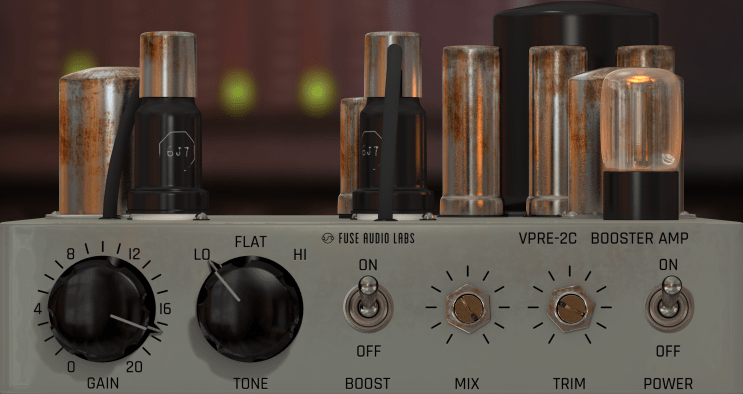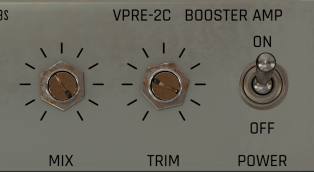If you enjoy this review and decide to grab the deal, please consider clicking through one of my links before you buy. I earn a small commission at no cost to you, which helps support this site and keep the reviews coming. Thanks!
Today we’ll be checking out the newest plugin from Fuse Audio Labs, VPRE-2C, which is an emulation of a 1950s tube preamp of the same name. Fuse claims that it will “enrich your recordings with an authentic tube vibe in the most intuitive way.” Did they hit the mark? Let’s find out!
Looks

Fuse Audio Labs VPRE-2C opens to a convincing picture of a vintage tube preamplifier, complete with the silkscreened lettering, pointer knobs and heavy-duty switches. When “powered on,” the output tube on the far right glows orangeish-red. The cap covers in the image even have a vintage-looking patina. All six of the controls are available at-a-glance. Overall, an attractive and simple interface.

Features
VPRE-2C has a simple, clean, what-you-see-is-what-you-get set of controls that will feel familiar to anyone that has ever used a preamp. Let’s take a look at the controls in detail:
Gain, Tone and Boost

The Gain control in VPRE-2C ranges from zero to twenty. Zero through about ten increases saturation and midrange warmth, while settings above ten add an increasing breakup that becomes truly dirty around the fifteen mark. By the time you hit twenty it’s a full-on distortion, heavily centered in the midrange frequencies.
Boost takes the Gain control and puts it on steroids. With the Boost turned on the breakup starts much lower Gain levels, and becomes a full-on fuzz by fifteen on the Gain. I really enjoyed the contrast of setting the plugin to the same Gain on both channels and only setting the Boost on one.
In an early draft of this review, I said that I couldn’t perceive much of a difference when employing the tone control. After publishing, I had a few conversations with users of the plugin as well as the plugin’s author and was given some pointers on how to better use the tone knob. Armed with this new knowledge, upon reconsideration and additional testing I found the tone control in VPRE-2C subtle, but subtle in a good way.
When running VPRE-2C through a bassier track, the difference was immediately apparent. I found the tone control especially useful at higher gain settings. I stand by my original summation that the tone control is subtle, but now see that it is more useful than I found it to be in my original draft.
(Editor’s note: It should be noted that this reconsideration did not change the overall scoring of my review, as I had previously scored VPRE-2C at 5 stars and still feel the same about its overall usability and features. Please check out my Review Policy If you have questions about how reviews are scored and my review reconsideration guidelines.)
Mix, Trim and Power

The last three controls are self-explanatory: Mix is a simple blend control that controls dry/wet. Trim is a master gain control that affects total output of the plugin. Power is a straight bypass control. I found adjusting the Mix and Trim to be a fun way to change the overall character of the plugin.

Usability
The best way I can describe using VPRE-2C is that it’s subtle – until it’s not. At its lower gain levels, the difference is almost imperceptible on its own, however, when added into a mix the difference becomes more apparent. I opened a track I’m working on and added VPRE-2C to the signal path to test it out, and can confirm that low-gain settings add a pleasing warmth to the midrange that helps the vocal pop through the mix.
At higher gain, especially with the Boost enabled, VPRE-2C goes from gritty to downright dirty, adding in a delicious breakup at around 15 on the dial that is simply infectious. I plugged in my studio guitar and was very pleased with the tonal variety I was able to get with VPRE-2C alone. Then, by adding VPRE-2C into my effects chain on a guitar track, I was able to bring out a midrangey warmth that was great for soloing in conjunction with other plugins.
One very cool, and perhaps unintended use that I found while testing the CPU usage of VPRE-2C – which is extremely low, by the way – was the sound that comes out when you stack the plugin. I put 5 instances of VPRE-2C in each channel of a guitar riff, 10 instances in total, and cranked them all up to the max. This gave me a fun, dirty low-fi fuzz. Again, not the original intention of the plugin, but speaks well to its versatility and efficiency.

Hear it in Action
I had a lot of fun playing around with VPRE-2C. First up in the samples is a stereo acoustic guitar track. The top sample is with VPRE-2C at the beginning of the effects chain for each of the two stereo tracks, with the soundboard mic set to Lo tone and the 12th-fret mic set to Hi. You can really hear how the midrange and mid-bass frequencies pop out and the plugin adds a pleasant saturation. The second sample is a dry track for comparison.
As mentioned above, I stacked a bunch of copies of VPRE-2C in order to test the CPU usage and found a fun fuzz tone. The next sample is of the ten instances stacked five per channel all cranked to the max, with one channel set to low Lo tone and the other to Hi, followed by the same guitar track with just one single instance per channel set to about 16 gain with no boost and similar tone settings:
Fuse Audio Labs VPRE-2C Review – The Bottom Line
In my testing I found VPRE-2C to be useful for vocals, guitar, and bass, as well as stuck at the beginning of the effects chain on virtual instruments. I feel that Fuse Audio Labs VPRE-2C is both affordable and versatile and a true value at its retail price point.

VPRE-2C is an attractive, fun, WYSIWYG-style plugin with a ton of uses. Though I found the Tone control to be a bit subtle, subtle does not equal bad. When set to opposites on each channel, the Tone control helped create a very cool stereo image, and the Boost control takes this plugin to the next level with an addictive warmth and saturation in the low-mid frequencies. Fuse Audio Labs’ VPRE-2C will definitely make appearances on my tracks going forward. I give the plugin an overall 5-star rating and my full recommendation.

VPRE-2C is an attractive, fun WYSIWYG-style plugin recreating a 1950s tube preamplifier at a solid price point.

